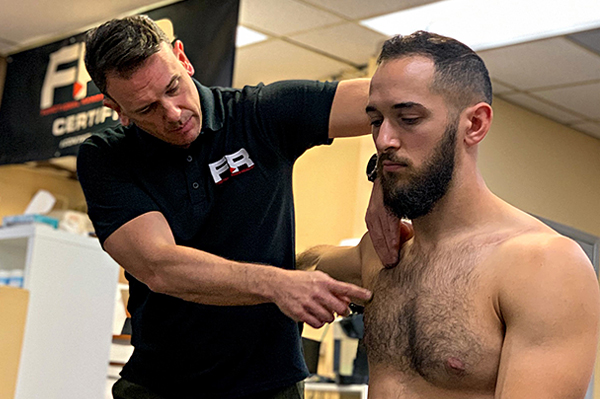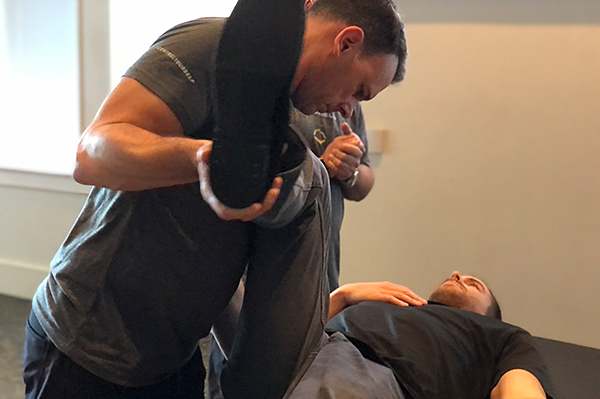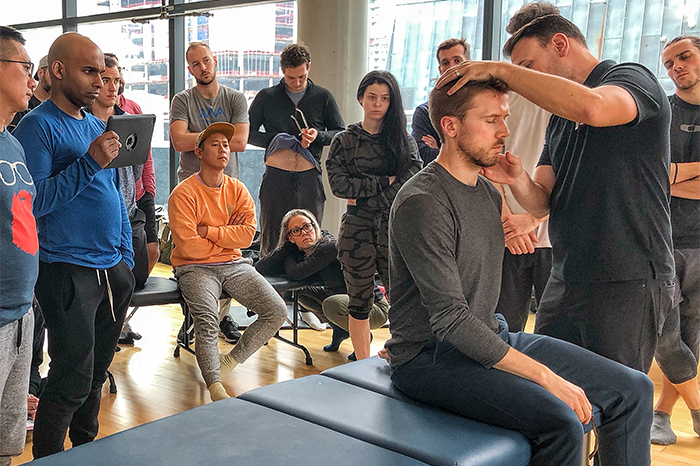FR® Assessment Principles
In conjunction with a sound medical history, advanced diagnostic procedures (when needed), and functional assessment, the FR® management system utilizes a scientifically guided approach to the assessment specific anatomic structures using palpation. This allows certified FR® practitioners to not only efficiently locate and delineate anatomic structures, but also to interpret tactile information allowing them to make clinical decisions regarding appropriate treatment and rehabilitative.
Many have noted that with sufficient practice of the FR® palpation procedures they are able to “see with their hands” therefore allowing them confidence to rely on their sense of touch to guide their clinical decisions.


FUNCTIONAL ANATOMIC PALPATION SYSTEMS (F.A.P.)™
Functional Anatomic Palpation Systems (F.A.P.)™ is an advanced, systematic approach to soft tissue palpation taught at FR® certification seminars whereby the practitioner learns to delineate, feel, and therefore assess very specific anatomic structures. Utilizing various concepts such as reference structures, layering technique, and epimysial groove assessment, the F.A.P.™ system is unparalleled in its ability to allow the practitioner to localize and identify symptomatic tissues.
Once identified (or located), the FAP™ system also allows the practitioner to actually interpret what they are feeling. This aspect of palpatory assessment is surprisingly omitted from most manual educational institutions who focus simply on “anatomy identification.” Interpretation of findings refers to the ability to translate tactile sensations into clinical decisions. In order to do this, one must first be able to define what they are feeling, and have a clear understanding of normal vs. abnormal anatomy. These concepts constitute a main focus of the FAP™ system taught at FR® certifications.
Further, as is the case when trying to master any skill, mindful, dedicated practice/training is necessary. Thus part of the FR® certification seminars includes dedicated training of palpatory skills.


TISSUE TENSION TECHNIQUE™
While it is often claimed that manual practitioners feel for “scar tissue” or “adhesions,” these terms simply represent inaccurate analogies. “Scar tissue” (or fibrosis) represents normal tissue laid down in a haphazard fashion. Therefore, if a single tissue fiber is oriented in the wrong direction, this is technically considered “scar” tissue. Because human touch receptors are UNABLE to feel or distinguish such small variations, those who claim to palpate them are making an inaccurate, and highly unscientific claim. One must therefore wonder if practitioners truly understand what they are feeling for?
The FR® system utilizes a more scientifically logical approach when it comes to palpatory assessment. Instead of feeling for “scar tissue,” “knots,” “ropeyness,” and other unrealistic findings, FR® practitioners practice, and master the art of finding, and defining areas of abnormal tissue tension (restrictive forces countering the ability to produce efficient movement) which is believed to represent areas of fibrotic tissue. Further, the FR® system teaches practitioners to distinguish between mechanical tension (tension created by the deposition of fibrosis), and neurological tightness (tissue tension deriving from increased neural discharge). This distinction is of utmost importance when attempting to select the appropriate treatment method or modality.
The FR® system first utilizes FAP™ method to locate tissue lesions, and then what is known as the Tissue Tension Technique to define said lesions in order to form sound clinical decisions regarding treatment application.
FR® Treatment Principles
The selection and application of sound soft tissue treatment depends greatly on the practitioner’s ability too not only locate, but also to define soft tissue lesions. Further, only with an advanced understanding of the target tissue’s composition, as well as the histological process underlying the injury can one create the most effective, and efficient treatment strategy guided by science.
These concepts constitute a large focus of the Functional Range Release® technique certification seminars. FR® practitioners are therefore able to truly define musculoskeletal lesions or biomechanical dysfunction making their treatment results specific, and effective.
On the surface, application of the FR® release technique would appear to the observer to be similar to various other myofascial release applications. The difference lies in the specifics …and there are a lot of them! Functional Range Release® technique does indeed draw upon previously utilized strategies, concepts, and approach’s however adds multiple improvements based on the current scientific literature making it a completely new and improved approach to musculoskeletal management.
One of the main factors that separates Functional Range Release® from other soft tissue techniques is the focus on understanding the target tissue. For the most part, soft tissue techniques have focused primarily on the treatment of muscular tissue by means of soft tissue manipulation and/or stretching. However when considering the physical make-up of muscle tissue, it is simply composed of contractile proteins (i.e. actin, myosin, etc.) situated in a series, grouped into bundles. Each fiber, bundle, and muscle is encased by fascia (a form of connective tissue). These fascial layers are then continuous with various other forms of connective tissue in the body (e.g. tendons, ligaments, capsules, bone, etc) forming full-body continuity.
The goal of soft tissue therapies has never been to tear muscle proteins apart. It has been to remove restrictive “scar tissue,” or fibrosis. But where does this fibrosis form?
Injury to tissue is followed by various processes including:
- Remodeling of connective tissue with lower tensile stiffness and a lower ultimate strength
- Randomized collagen fiber direction and deposition (fibrosis)
- Inability of collagen bundles to slide easily past one another due to cross-linking
- Inflammation
- Substitution of collagen types with those of lesser strength
- Fascial contraction
- Increased neural drive to muscular tissue causing protective spasm
Considering the process outlined above, the intended target with the application of various soft-tissue therapies should not be the ‘muscle‘ as is commonly believed, but rather the surrounding and continuous connective tissues where the fibrosis actually develops. Thus the goal of the manual ‘release’ portion of the FR® system is to reduce tissue tension via the application of specifically applied forces which act to influence the long term re-sculpting and/or remodeling of disorganized connective tissue (“scar tissue”) creating tissue of better quality, elasticity, and resilience. In so doing, FR® Release normalizes tissue structure and function when applied in addition to its rehabilitative approaches.
It would be easy to assume that the soft tissue therapies currently being utilized have been working on the connective tissues all along. However this assumption is incorrect. This is because the research demonstrates that connective tissue does not respond in the same manner as muscular tissue. Thus many changes in soft tissue application must be made in order to expect permanent, favorable changes in target tissue structure with soft tissue application. These necessary alterations in treatment application form the basis for the Functional Range Release® soft tissue management system.
FR® Rehabilitation Principles
Progressive & Regressive Angular Isometric Loading (PAILs/RAILs)
PAILs & RAILs™ procedures utilize specific isometric loading strategies for the purposes of enhancing neurologic function and control across articulations, as well as to induce progressive adaptations in connective tissue structures improving their structural quality and resilience.
PAILs & RAILs are used in conjunction with FR® release procedures for several reasons:
- To produce internal tissue load that helps to stimulate specific remodeling of connective tissues
- To aid, and speed up soft tissue healing and repair
- To over come the neuromuscular barrier that develops post injury (muscle guarding/spasm)
- To expand the usable range of motion across articulations by developing angle specific strength (teaching the nervous system how to control expanded ranges of motion)


They have been successfully utilized in the treatment and rehabilitation of several musculoskeletal conditions including (but not limited to):
- Tendonopathy or Tendonosis, Tendonitis
- Muscle and tendon strains or tears
- Ligament sprain
- Instability or hypermobility
- Fascial tears
- Post-surgical rehabilitation
- Joint restriction
- Postural de-compensation
- Movement dysfunction
- Motor control dysfunction
UPCOMING FR® SEMINARS
| Event | Venue | Date | |
|---|---|---|---|
| FR® Upper Limb Certification (Worldwide) - ONLINE SEMINAR | ONLINE SEMINAR | Aug 16, 2025 | Register |
| Non-Therapist FR® Upper Limb (Worldwide) - ONLINE SEMINAR | ONLINE SEMINAR | Aug 16, 2025 | Register |
| FR® Lower Limb Certification (Worldwide) - ONLINE SEMINAR | ONLINE SEMINAR | Sep 27, 2025 | Register |
| Non-Therapist FR® Lower Limb Certification (Worldwide) - ONLINE SEMINAR | ONLINE SEMINAR | Sep 27, 2025 | Register |
| FR® Spine Certification (Worldwide) - ONLINE SEMINAR | ONLINE SEMINAR | Nov 1, 2025 | Register |
| Non-Therapist FR® Spine (Worldwide) - ONLINE SEMINAR | ONLINE SEMINAR | Nov 1, 2025 | Register |
UTILIZED BY TOP PROFESSIONALS AROUND THE WORLD

















































